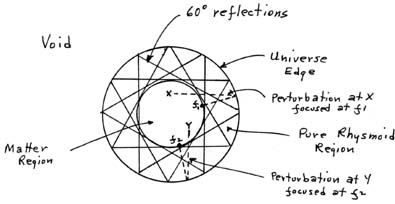The Universe: A Finite Spherical System
Introduction ~
Currently popular cosmological models for the universe are the Big Bang theory, the Oscillating theory, and the Steady-State theory. In the Big Bang version, the universe is supposed to have begun as a ‘primeval’ atom which contained all of the mass of the universe and exploded about 15 billion years or so ago, resulting in the apparent expansion seen today. In the Oscillating version, the universe does not expand forever,, but because of serlf-gravitation, stops, and then collapses to the ‘primeval’ atom state again to repeat the cycle. In the Steady-State version, constant mass and mean density is postulated. Since this theory also calls for expansion, continuous creation of matter is needed to maintain the mean density constant.
As noted above, the current theories all postulate expansion of the universe as evidenced by the Hubble relation of velocity-distance for the galaxies. In addition, various geometries are also postulated, for example, Einstein’s 4-dimensional space. This all results in the necessity for many ad hoc explanations for these effects. However, rhysmonic cosmology, since it starts with very basic assumptions, effectively eliminates the need for such ad hoc assumptions and becomes a general theory for all known and yet unknown effects.
Rhysmonic Postulates ~
The universe in terms of rhysmonics requires but a few postulates which will be listed here:
1. The universe is Euclidian in geometry.
2. Matter particles (mass) form only in the central portion of the universe.
3. The edge of the universe is a perfect reflector of radiant energy and thus the universe is a true black body.
4. The universe is finite, spherical, and of constant energy content.
The above postulates will be only briefly developed in this article but will be more completely developed as the development of rhysmonic cosmology unfolds.
Geometry of the Universe ~
As was shown in Figure (1), the basic cell of the matrix structure of rhysmonics is a hexagonal system where directed vectors make angles of 0o, 60o, 90o, or 120o with each other, in the plane or in the 3-dimensional volume. Since the planar structure builds up into a hexagonal 3-dimensional Euclidian system and this system repeats up to its maximum (universe) dimensions, the Euclidian geometry of the matrix cell also continues out to the maximum universe dimension, i.e., the rhysmonic geometry remains Euclidan, except, perhaps, under highly localized conditions. Thus, the rhysmonic universe is Euclidan.
Figure 1: Construction of a 2-Part Universe (Planar View) ~

Matter in the Universe ~
It was indicated in Figure (2) that matter (mass) particles form only out to the half radius point in the rhysmoid universe. This is primarily due to two factors as depicted in Figure (3). First, due to the rhysmoid’s hexagonal geometry, ideal 60o reflections from the edge of the universe will be limited to the outer one-half radius, and thus this region will tend to remain a pure rhysmoid. Second, any perturbations within the center half of the rhysmoid sphere will reflect off the spherical edge of the universe to the focal plane which is also the edge of the center matter sphere, thus maintaining the outer half radius as pure rhysmoid. By the same token, perturbations at the focal plane can be reflected off the universe edge and possibly be statistically combined at different points in the matter region, creating the excesses and deficiencies of rhysmons which make up the matter in this region. While this matter in the central region is created randomly, the matter would probably be organized in some fashion by gravitational effects which would appear with the creation of this mass or mater. It is also feasible that possible collisions between multiple universes (possible in rhysmonic cosmology) may also create mater in this region by shock action.
Figure 2: Planar view of rhysmonic universe ~

Figure 3: [missing]
Reflections at Rhysmoid Edge ~
Consider the simplified planar basic cell of Figure (1) a being at the edge of the universe. Note the directions of the four rhysmoid vectors depicted in this figure. At a time T* later, or 5.391 x 10-44 seconds later, the direction of these vectors reverse as the rhysmons in each closed loop of the complete matrix cell continue around in ‘orbit’. The original direction is then restored T* (Planck Time) later. There fore, since this matrix structure is repeated throughout the universe, the universe is like a perfect ‘machine’ in which reality as we perceive it, has a cinematic continuity, where each single ‘picture’ in the cinema of existence lasts for only 5.391 x 10-44 seconds. Rhysmonics, therefore, restores Newton’s concepts of absolute space and time in the universe.
It will be shown later, that these rhysmonic vectors, since they reverse in time T*, some perturbation effects in the universe can be essentially instantaneous effects, and form the basis of gravitation. Thus gravitation is essentially an instantaneous effect, or ‘action at a distance’. It will be shown that electromagnetic propagation effects require a finite velocity, C*, which is the velocity of light as determined by other means. Therefore, while all radiative energy will be shown to reflect off the universe edge in the reversing vector process, only gravity effects are ‘instant’; EM wave effects require a finite velocity. These concepts are important in explaining some of the paradoxes in astronomy.
Summary & Conclusions ~
The size of the universe depends only on the number of rhysmons and the size of the matrix cell. The size of the cell has been given by Planck’s absolute units, and the energy content by Planck’s Constant. Therefore, the rhysmonic universe builds p from these basics and there is no need for atom-smashing experiments to determine the basic structure of the universe. The universe is a finite system.